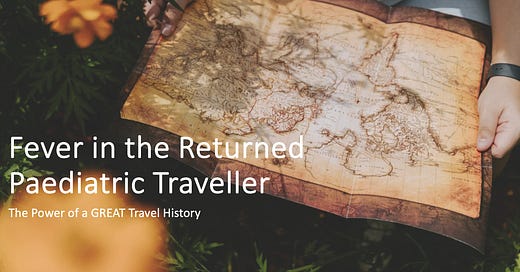Fever in the Returned Paediatric Traveller: The Power of a GREAT Travel History
Understanding Risk, VFR Vulnerability, and Why History is Everything
When a child presents with a fever after returning from overseas travel, the diagnostic landscape shifts. The usual suspects—viral illnesses, common infections—remain, but now the differential balloons to include a spectrum of imported pathogens, many unfamiliar, some potentially life-threatening.
This two-part series provides a structured clinical approach for healthcare providers assessing febrile illnesses in children after travel. In Part 1, we unpack the unique challenges in paediatrics, the risk amplification in VFR (visiting friends and relatives) travellers, and how a thorough history, guided by the GREAT mnemonic, can steer your workup in the right direction.
Why Paediatric Fever Post-Travel is Extra Tricky
Children often present diagnostic puzzles—even more so in a post-travel context. They may:
Struggle to communicate clearly.
Have vague or non-specific symptoms like fatigue, fever, or abdominal pain.
Variable incubation periods: Some infections (e.g. malaria, hepatitis A) can present weeks after returning home, obscuring the temporal link between exposure and illness.
Examination cooperation and obtaining adequate diagnostic specimens require specific paediatric skills and strategies.
This makes a high index of suspicion and meticulous history-taking essential to avoid missed or delayed diagnoses.
The Hidden Vulnerability of VFR Travel
One key risk multiplier is the VFR traveller. Children travelling to visit friends or relatives abroad face unique and often underestimated exposures:
Longer trips increase cumulative exposure risks such as TB.
Rural stays expose them to inadequate sanitation, vectors, and poorly resourced health systems.
Home-based stays might involve unfiltered water, greater interaction with locals, more street food—whatever you want. Following personal protective measures, like avoiding mosquitoes, may also be less rigorous. more street food, you name it. Adherence to personal protective measures like mosquito avoidance may also be lower.
Lower uptake of pre-travel advice leads to missed vaccines or prophylaxis. After all, they are travelling to a familiar environment—home—where they feel safe!
Unlike tourists, VFR travellers are often less protected, despite being more exposed—a paradox with real clinical consequences.
Studies consistently show VFR travellers are disproportionately affected by serious diseases like malaria, typhoid, and hepatitis A.
🕵️♂️ The GREAT Framework: History-Taking That Saves Lives
In fever post-travel, history is your most powerful diagnostic tool. The GREAT mnemonic ensures nothing critical slips through the cracks:
G – Geography and timing: Localises incubation periods, seasonal patterns, and geographic disease prevalence. Endemic disease maps is useful. Websites like TravelHealthPro provide information about specific countries, outbreaks, the latest news, as well as fact sheets.
R – Risk behaviours and Exposures.
Helps identify routes of zoonotic, waterborne, and vector-borne transmission.
E – Eating/ Drinking and Extra Precautions.
Food/waterborne illness risk; pre-travel vaccines or prophylaxis.
A – Activities, Accommodation, Age-specific behaviours:
What did they do? Where did they sleep? Air conditioning or mosquito nets? Children often find themselves doing things they shouldn't, like playing with animals in the streets or taking part in activities that scare adults.
T – Traveller type and host factors
Certain traveller types (e.g., VFR) and rural/long-term stays increase risk. Tailors the risk assessment to the child’s unique vulnerabilities and exposures.
Use this framework early, and you’ll often be two steps ahead in diagnosis before a single test is ordered.
🛡️ Pre-Travel Planning: Missed Opportunities, Especially in VFRs
Many travel-related illnesses in children are preventable—but prevention is only effective if it happens. Some things to consider:
Routine and travel-specific vaccines (e.g. influenza, typhoid, yellow fever, hepatitis A).
Malaria prophylaxis and insect bite prevention education.
Safe food and water habits.
Where and when to seek help.
Animal safety.
Road safety.
Sadly, VFR travellers often don’t access pre-travel care, whether due to cost, oversight, or a false sense of immunity.
Key Takeaway
Fever in a returned child should always prompt a travel-focused history. Pay particular attention to:
Children with VFR travel (red flag group; risk amplifiers for illness, with less pre-travel planning).
Delayed presentations that obscure the connection. Infections have variable incubation periods.
Subtle but significant exposures (freshwater, bites, food, etc.).
Use the GREAT history framework to guide and structure your evaluation/ examination, and you’ll likely catch key clues that can shorten time to diagnosis and management of the patient.
As I always tell my juniors:
A thorough travel history and exam sharpen the differential.
Clear differentials guide targeted investigations.
Meaningful results drive better care, stewardship, infection control, and public health action.
💡 In Part 2, we’ll build on this history with a syndromic diagnostic approach, (re)examine how to select the appropriate microbiological tests, discuss infection control implications, and understand when and how to engage with public health authorities.
References:
Yellow Book. Post-Travel Evaluation of the Ill Traveler. https://www.cdc.gov/yellow-book/hcp/post-travel-evaluation/post-travel-evaluation-of-the-ill-traveler.html
Fever in the returned child traveller: assessing for imported causes - Medicine Today, accessed April 16, 2025, https://medicinetoday.com.au/mt/2023/december/feature-article/fever-returned-child-traveller-assessing-imported-causes
Fever in the returned traveller - Starship, accessed April 16, 2025, https://starship.org.nz/guidelines/fever-in-the-returned-traveller
(PDF) Fever in the Returned Pediatric Traveler - ResearchGate, accessed April 16, 2025, https://www.researchgate.net/publication/353949613_Fever_in_the_Returned_Pediatric_Traveler
The contribution of travellers visiting friends and relatives to notified infectious diseases in Australia: state-based enhanced surveillance - PubMed Central, accessed April 16, 2025, https://pmc.ncbi.nlm.nih.gov/articles/PMC5111124/
Risk activities and pre-travel health seeking practices of notified cases of imported infectious diseases in Australia - ResearchGate, accessed April 16, 2025, https://www.researchgate.net/publication/323663972_Risk_activities_and_pre-travel_health_seeking_practices_of_notified_cases_of_imported_infectious_diseases_in_Australia










